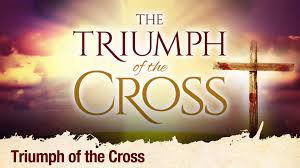The Triumph of the Cross: God Loves Us
For five years I lived in one of the most beautiful places in our country, believe it or not, in New Jersey. I attended Don Bosco Seminary in Sussex County, the Northwest corner of New Jersey.
Sep 11, 2014

Exhaltation of the Cross
(Year A)
Readings: Numbers 21:4b-9;
Philippians 2:6-11
Gospel: John 3:13-17
For five years I lived in one of the most beautiful places in our country, believe it or not, in New Jersey. I attended Don Bosco Seminary in Sussex County, the Northwest corner of New Jersey. This is an area of green rolling hills and the most colorful autumns you could ever imagine. It is hard to explain the hills of New Jersey to folks who have lived in the flat area of Florida all their lives. The hills just seem to pop up everywhere. Naturally the main roads are in the valleys between the hills.
When the Salesians of St. John Bosco who ran Don Bosco Seminary first arrived in Sussex County in the 1920’s, they were greeted with a most unpleasant sight. On the hill directly across from the seminary, the local Ku Klux Klan had erected a burning cross to welcome the Catholics. Anti Catholicism was part of their many prejudices. Time went on. The seminary and the order grew. The KKK faded away, at least from Northwest New Jersey. Forty years later, the Salesians remodeled their chapel. In the center of the sanctuary, they placed a large burnt cross as a sign that the hatred of men could not destroy the love of Christ. Sadly, this cross was replaced by a traditional crucifix, but the burnt cross made a lasting impression on me and on many others.
Today we celebrate the Feast of the Triumph of the Cross. This feast goes back to the seventh century when the Cross was recovered from the Persians and exposed for veneration in Jerusalem. The Triumph of the Cross is the Triumph of Jesus Christ whose love for us and obedience to his Father climaxed with his death on the cross. Moses lifted up the serpent on the cross in the desert. People looked at this cross, the prefigured Jesus’s cross, and were healed. In John’s Gospel, we hear Jesus telling Nicodemus that he would be lifted up so that all who see him and believe in him would have eternal life. For God so loved that world that he gave his only Son that whoever believes in him may not die but may have eternal life.
The cross is the symbol of the Christian. It is our sign of our personal relationship with our Savior. He died not just for people in general but for me and for you. He calls us to join him on his cross not just as a people but as individuals. The ideal that he realized is the goal of our lives, to make real the only true love there is: sacrificial love. Some people treat the cross as a trinket. Other people treat the cross in a superstitious manner.
Some people will give a cross powers that belong to God. These people have seen too many cheap horror movies and act as though a cross can defeat evil spirits. It is not the object that conquers evil, it is the power of Christ whose presence the object reminds us of, that conquers evil.
The deeper meaning of the Cross is presented in today’s second reading from the Letter of Paul to the Philippians. Jesus emptied himself completely, not just becoming a human being but accepting the worst public death of the society he was in to demonstrate the extent of the love of God for us. He died making a willing statement of love, filling the world with the love he had for his Father and his Father has for him. We are saved from the horrors of evil, from meaningless lives due to the love of the Lord. Because Jesus died on a cross for us we are able to proclaim to the world: Jesus is Lord. His love made this possible. When we wear a cross we are saying: Jesus is Lord of our lives.
This is the ideal set before us: as followers of Jesus, as people with a personal relationship with the Lord who loves each of us, we have to be willing to sacrifice everything we have to fill the world with the Father’s love. Our daily turmoil, our problems, our pains all take on an infinite value when we trust them to Jesus, when we unite them to his cross, to our cross.
How much does God love the world; so much that He gave His only son to the world so that when He would be lifted high on a cross that all might be saved through him.
Praised be Jesus Christ in whose cross we find meaning in this life and eternity in the next.-- By Fr Joseph A Pellegrino
Thoughts of the Early Church
As Moses lifted up the serpent in the wilderness, so must the Son of man be lifted up, so that all who believe in him may not perish but may have eternal life.
With the wonderful skill he has in imparting heavenly teaching, the Lord of the teachers of the Mosaic law shows us that law’s spiritual meaning, as he recalls the old history and explains its symbolic reference to his own passion and to our salvation.
The Book of Numbers relates that the Israelites, wearied by the long hard journey in the wilderness, grumbled against the Lord and Moses, and therefore the Lord sent fiery serpents among them. Many died of their bites, and when the people cried out to Moses and he prayed for them, the Lord commanded him to make a bronze serpent and set it up as a sign.
“Those who are bitten,” he said, “have but to look at it and they will live”; and so it happened.
Now the bites of fiery serpents are the evil temptations to sin that bring spiritual death to the soul deceived by them. It was good for the people who grumbled against the Lord to be prostrated by the bites of serpents, for this outward scourge would make them realize how much inward damage they suffered because of their grumbling.
The bronze serpent that was raised up so that those who were bitten might look at it and be healed represents our Redeemer in his passion on the cross, for the kingdom of death and sin is conquered only by faith in him.
The sins which drag both soul and body to destruction are well described as serpents, not only because they are fiery and poisonous and cunning enough to destroy us, but because a serpent persuaded our first parents, who were immortal, to commit the sin through which they became subject to death.
Our Lord, who came in the likeness of sinful flesh, is rightly portrayed as the bronze serpent because as the bronze serpent was the same as the fiery serpents except that it contained no poisonous or hurtful fire, and when it was raised up it healed those bitten by serpents, so also the Redeemer of humankind clothed himself not in sinful flesh, but in the likeness of sinful flesh, in which, by suffering death on the cross, he delivered those who believe in him from all sin and even from death itself.
“Therefore as Moses lifted up the serpent in the wilderness, so must the Son of man be lifted up”; for as those who looked at the bronze serpent set up as a sign were for a time healed of the physical death and injury produced by the serpents’ bites, so also those who look at the mystery of the Lord’s passion, believing, confessing, and sincerely imitating him, are saved completely and for ever from the death of both soul and body which they had incurred through sin.
Accordingly the text continues: “so that all who believe in him may not perish, but may have eternal life.” These words make it clear that whoever believes in Christ not only escapes the pain of punishment but also receives a life that is eternal.
And here we see the difference between symbol and truth, for the one prolongs this temporal life, while the other gives a life that will be endless.
We must make sure, however, that the truths our minds perceive are given fitting practical expression, so that by confessing the true faith, and living devout and disciplined lives, we may deserve to attain the fullness of the life which has no end. -- Bede







Total Comments:0